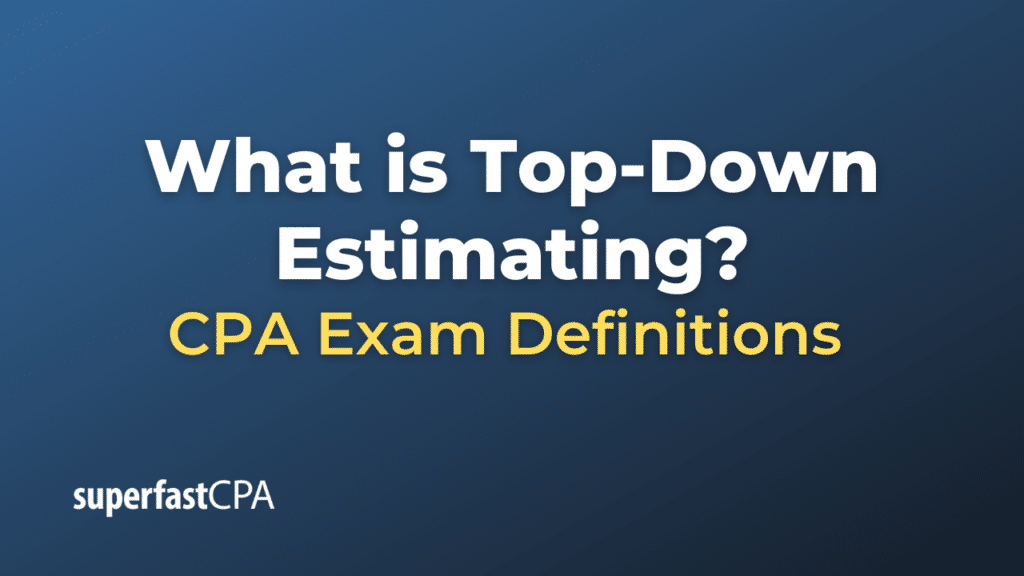Top-Down Estimating
Top-down estimating, also known as “analogous estimating,” is a method used in project management to derive an estimate of a project (or parts of a project) based on the overall project or similar past projects. Instead of diving into detailed costs or tasks immediately, the estimator starts with a global view and then breaks the project down into smaller components, distributing the overall estimate among them.
The top-down approach contrasts with the bottom-up approach, where detailed estimates for individual tasks are developed first and then aggregated to provide an overall project estimate.
Steps in Top-Down Estimating:
- Determine the Overall Estimate: This is often based on historical data from similar projects or expert judgment. For instance, if a similar past project cost $100,000, the new project might be estimated in that ballpark.
- Break Down the Project: The project is divided into its main components or phases.
- Allocate Budget to Components: The overall project estimate is distributed among the various components based on their perceived importance or complexity. For example, if one phase is considered to be twice as complex as another, it might receive twice the budget.
- Refine as Needed: As more details emerge, refine the estimates. The initial top-down estimate may be adjusted as the project proceeds and more information becomes available.
Advantages of Top-Down Estimating:
- Quick and Simple: It’s faster than detailed estimation methods, which can be beneficial in the early stages of a project when detailed information may not be available.
- Useful for Early Decisions: It can be useful for initial project feasibility studies, approvals, or when you need a rough estimate to set client or stakeholder expectations.
Disadvantages:
- Less Accurate: Because it’s based on high-level data or past projects (which may not be directly comparable), the accuracy can be lower than detailed bottom-up estimates.
- Potential for Misallocation: If the breakdown of the budget among components isn’t done accurately, it can lead to some areas being underfunded and others overfunded.
- May Overlook Details: Some specific tasks or costs might be overlooked in the initial estimate.
Example of Top-Down Estimating
Let’s use the example of a company that plans to organize a corporate event and needs to estimate the budget for the entire event using the top-down estimating method.
Scenario:
XYZ Corporation wants to organize an annual corporate event for its employees. Based on past experiences and considering inflation and additional requirements, the management believes the event might cost around $20,000.
Step 1: Determine the Overall Estimate:
Using historical data from last year’s event, which cost $18,000, and factoring in some expected inflation and additional activities, management estimates the cost for this year’s event to be $20,000.
Step 2: Break Down the Event:
The event is divided into its main components:
- Venue rental
- Catering
- Entertainment
- Transportation
- Miscellaneous expenses
Step 3: Allocate Budget to Components:
Based on the importance and expected costs of each component, the $20,000 budget is divided as follows:
- Venue rental: $8,000
- Catering: $6,000
- Entertainment: $3,000
- Transportation: $2,000
- Miscellaneous expenses: $1,000
Step 4: Refine as Needed:
As the event planning progresses:
- The event manager finds a venue that meets all requirements but costs $7,500. This is $500 less than estimated.
- Catering bids come in around $6,500, which is $500 more than estimated.
- Entertainment, transportation, and miscellaneous expenses are on target.
In this case, the savings from the venue can cover the additional catering costs. If not, the manager would have to revisit the estimates and make necessary adjustments, perhaps by cutting costs in other areas or seeking additional funds.
This example illustrates how top-down estimating provides a starting point for the budgeting process. As the event planning progresses and more detailed information becomes available, the initial top-down estimates are adjusted to reflect the more accurate bottom-up estimates.













